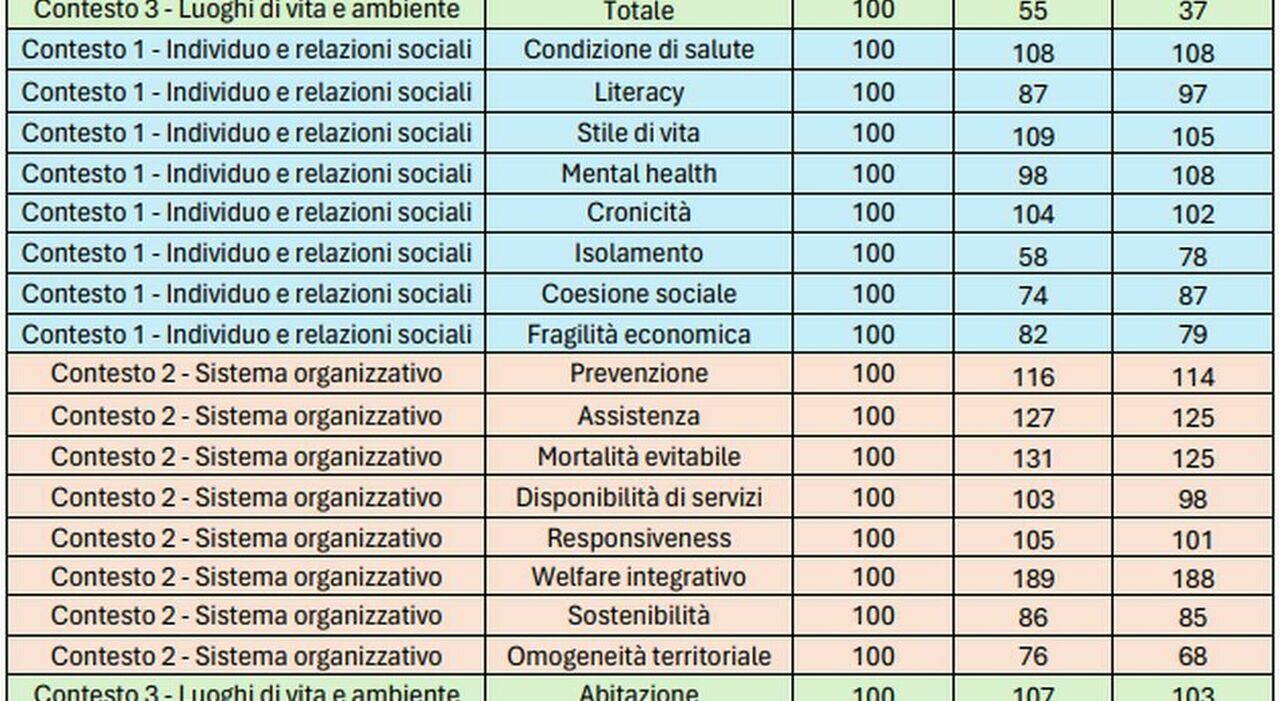The recovery does not take off after the years of the pandemic, health is precisely the element that has paid the highest cost: both in terms of isolation, disintegration of social relationships, postponed medical visits and interventions, stress of healthcare personnel, vulnerability of styles of life and food due to climate change.
INSIGHTS
The decline continues even in the years that should be of recovery: the Health Proximity Index totaled 86 points in 2022, losing 14 points compared to the base value of 100 points set for 2010, the starting year of the survey. This dropped another 4 points compared to 2021 in which 90 points were recorded.
The concept of “Proximity to health” means the relationship in space and time that exists between the person and the availability of health benefits and the possibility of enjoying them. That is, ensuring that the moment in which the need for health arises, the moment in which this need is captured, the moment in which a response is provided and the moment in which the recipient actually benefits from it ARE AS CLOSE AS POSSIBLE .
The Bruno Visentini Foundation proposes the second edition of the Report which measures the Health Proximity Index which examines the trend of 72 indicators organized in 3 Contexts and 22 Domains.
Objective, to verify how the dynamics, services and health conditions are changing from 2010 to today. A research effort culminating in the research report entitled ‘Connecting the dots: towards a National Health Plan’ presented today in the Zuccari room in the Senate on the initiative of Senator Ylenia Zscopio.
«Prevention, patient care, telemedicine, local assistance, socio-health services, the hospital, but also the local area, the third sector and the various welfare actors who nevertheless contribute to the protection of public health and individual, represent the many dots that must be joined in what must be a holistic approach to health needs, exactly as envisaged by the One Health logic” – declared Senator Ylenia Zscopio – “And how can the dots be joined if have we witnessed an increase in abnormal regulatory interventions in recent years? This can only be done through the creation of a moment of shared planning with all stakeholders at a national level, which defines the characteristics of the evolution of the health system, starting from a national health plan (the last one dates back to 2008), but also including the other elements that are fully ‘actors of health‘, such as the social or environmental component. A challenge that, in short, concerns us all.”
«In 2022, despite the multiple regulatory interventions, we have not yet seen a reversal of the negative trends which have worsened further compared to the previous year, and the multiple initiatives envisaged by the PNRR (many of which are still on paper) have not yet fully succeeded in improving the state of proximity to health for Italian citizens”, explains Professor Duilio Carusi, Adjunct Professor Luiss Business School, Coordinator of the Observatory: “the desire to provide solutions and answers has given rise to a proliferation of regulatory interventions and ad hoc plans often poorly connected and partly overlapping. An overall vision summarized in this work is still missing.”
«Starting from March 2020 we have witnessed a regulatory production in health matters characterized by hypertrophy. Prevention, chronicity, telemedicine, electronic health records, community assistance, hospital catchment areas have been the subject of various regulatory initiatives. To respond to the many critical issues identified, now more than ever there is a need to bring the healthcare sphere into dialogue with the components relating to social, socio-health and environmental protection assistance”, concludes Professor Carusi. The experts have underlined how it appears increasingly necessary to return to a planning effort at country level, which leads to a ‘National Health Plan’, which incorporates – and also integrates on extra-health dimensions – a National Health Plan.
The most relevant issues today for the population living in Europe are: being able to live not survive, live in healthy and safe communities and be able to benefit from health policies capable of ensuring them a better life both already today and for future generations. But in reality the data shows that over 20% of the population in the WHO European region (which also includes the states of the former Soviet Union, Turkey and Israel) live with preventable diseases which unfortunately severely limit their participation both to social and economic life. And the 20% of the poorest European population is at double risk of being affected by a mental illness, with the consequence that their treatment reaches costs that correspond to 4% of the GDP of the single State.
«However, says Dr. Christine Brown, Director of the WHO European Office for Investment in Health and Development based in Venice, the good news we can give today is that we already have solutions that can deliver results in the population in 4 years, managing to improve, for example, the health of as many as 250,000 people for a country of 60 million inhabitants: these solutions will be presented at the conference”. The “One Health” logic and the “Health in all policies” strategy, supported by the WHO and foreseen in the framework of the United Nations 2030 Agenda, require the health system to proceed in a multidisciplinary and transversal manner to be more effective today . This can only happen with an overall vision that includes new organizational and technological tools in a governance framework for human, animal and environmental health, shared and inclusive by all Member States.
© ALL RIGHTS RESERVED
